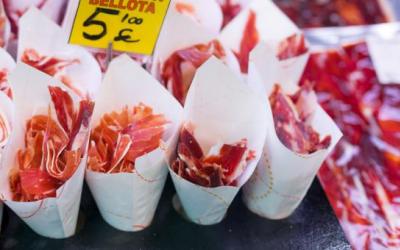Spain sets new pig price record
Factors
Elimination was driven by financial losses from ASF in Germany and Poland.
In the rest of Europe, feed prices are high compared to pig prices. New environmental and animal protection regulations are causing manufacturers to go out of business.
Mentioned a few weeks ago about the national production record system in Spain, which indicates that the average mortality rate from weaning to fattening has increased from 9% to 14% over the past two years, an increase of 5% - a significant part of the increase is due to the removal of copper sulfate and antibiotics. Now these rules apply throughout the European Union. We expect that this will lead to an increase in the case. The EU produces about 240 million commercial pigs per year. Each 1% change in mortality represents 2.4 million pigs. If mortality across the EU increases by 5%, like Spain, there will be 12 million fewer pigs per year on the market. Fewer pigs always result in higher prices, i.e. record breaking prices.
Below is a map of China showing when ASF outbreaks have been observed recently. In 2022, ASF was spreading in China, but without serious consequences. According to the input data, this disease is spreading more frequently. On the map, the darker the area, the more severe the flash. The darkest zone is the provinces of Liaoning, Hebei, Shandong, Shanxi. According to the latest data, the number of pigs in their four provinces exceeds 100 million heads. (in the context of US numbersis 73 million HEAD.). We estimate that the four provinces together could have about 9 million sows. There is anecdotal evidence that ASF leads to rapid mortality and elimination of sows. Some report between 20% and 80%. One person said he wasn't sure what that number was, but there are more and more empty production facilities every day.
When ASF hit China in August 2018, pig prices shot up by July 2019. The main reason in China is when herds are torn apart from ASF, pigs die or are slaughtered (with any weight). Their liquidation pushes the supply of pork up in short-term prices.
Last year, it was constantly reported that the sow eradication in China, which began in July 2021 due to the loss of 80 dollars / head for several months, led to the elimination of sows on a large scale. We observed a rapid increase in the price of pigs from 13 yuan/kg in April 2022 to over 25 yuan/kg by autumn – almost doubling or over 200 usd/head. On December 1, the price of Chinese pork is 23.65 yuan/kg. Then the country opened up and covid spread dramatically. Hundreds of millions of people felt unwell, and we expect that this reduced the demand for pork (when you are sick, how hungry are you?). The price of pigs rose from 23.65 yuan/kg to 15.12 yuan/kg, a drop of nearly $150.
We expect that with the advent of Covid, not only the demand for pork has decreased, but also the prices of pork have decreased, and producers have brought pigs to the market. We understand that the mass of pigs on the market dropped sharply after December 1st. Less demand - more supply = lower price.
What has been fought is because of the big outbreaks in China why the price of pigs has not recovered now. The liquidation of the sow stock, which we saw in high prices in the fall, has not receded. It doesn't happen that fast. Now wondering without the facts, new outbreaks of ASF that seem serious are pushing the proposal away from pig eradication? If so, it might get even more interesting as the previous liquidation due to financial losses will be complemented by a significant ASF eradication resulting in even fewer pigs?
The USDA is projecting a decline in US red MEAT production in 2023 compared to 2022. The first such year since 2014, the US has seen an annual drop (2014 was a great year for hog prices). In 2023 (March 3), US red meat production decreased by 1.8% compared to last year (beef -4.5%, pork +0.9%). We expect that in the coming months we will see a larger percentage drop compared to the year, which will help support the price of pork.
Of course, you can see that the rate of live births of piglets has increased significantly. Sow mortality increased significantly by almost 6% compared to 2014. SMS - The MetaFarms record system estimates a minimum loss of $1,000 per sow when one dies. Farm arithmetic 6% increase for 6 million sows = 360,000 dead sows per year x $1,000 = $360 million. Real money.
We all know the main reason for the increase in sow mortality. Too many genetic companies sell gilts that have rectal prolapse, become crippled, fail to recover from lactation, require hoof trimming, which is a reflection of a bad phenotype, bite the vulva, fail to adjust to gestation, and the like.
Read together with it:
- Парагвай: Экспорт субпродуктов является растущей отраслью и уже достиг 95,4 млн долларов СШАЭкспорт говяжьих субпродуктов в этом году значительно вырос. К концу августа выручка составила 95,4 млн долларов США по сравнению с 54,6 млн долларов США на тот же конец прошлого года. По данным SENACSA, в конце августа этого года было экспортировано 51 миллион килограммов мяса по сравнению с 33,7 миллиона килограммов на конец того же месяца прошлого года. Экспорт субпродуктов увеличился на 51,3%....
- Министерство сельского хозяйства США представило план по снижению цен на говядинуПоголовье скота в стране находится на самом низком уровне за последние 75 лет, в то время как спрос на говядину вырос на 9% за последнее десятилетие. Поскольку увеличение поголовья скота в стране требует времени, Министерство сельского хозяйства США (USDA) уже сейчас инвестирует средства, чтобы сделать эти рынки менее волатильными для скотоводов в долгосрочной перспективе и более доступными для по...
- С января по июль экспорт свинины из ЕС вырос на 1,6%На втором месте оказались Нидерланды с объёмом экспорта в 392 000 тонн. Дания экспортировала свинину в третьи страны с объёмом в 308 000 тонн, что примерно на 13% меньше, чем в предыдущем году. Германия экспортировала 180 000 тонн, что на 18% меньше, чем годом ранее. Это было обусловлено, главным образом, дополнительными ограничениями на экспорт, вызванными вспышкой ящура в начале года. Помимо зап...
- В Кремле пообещали ответ на санкции сообразно интересам РоссииДмитрий Песков В Кремле начали анализировать введенные санкции для разработки ответных мер, заявил пресс-секретарь президента России Дмитрий Песков, передает корреспондент РБК. «В настоящий момент анализируются те санкции, которые определены. Будем делать то, что наилучшим образом соответствует нашим интересам», — сообщил Песков, отвечая на вопрос об ответных мерах России. 19-й пакет санкции Еврос...





























































